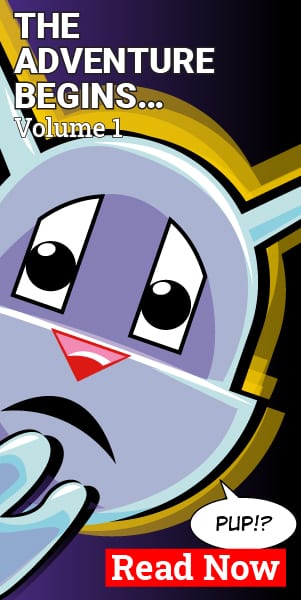By Pete Trbovich
The Internet revolutionized many media forms, and one of those is the comic strip medium. It was about time, too! The comics printed in the newspapers, many of them over 50 years old, have mostly become stale franchises drawn by a team of hacks after the original artist passed away. The World Wide Web introduced us to a fresh, exciting world of talent. It poured new life into what was almost a dead medium. Adding a comic strip to your website can provide any number of benefits. It can keep you in touch with a younger audience, attract traffic and ad revenue, serve as a platform for airing your own point of view, and in some cases provide extra income through the sale of books, T-shirts, and other branded gear. Here’s some tips to get one started:
- Choose a subject matter. What will your comic be about? Pretend you’re pitching a movie idea to a Hollywood agent and simplify your concept down to a sentence or two. Examples: “It’s a haunted-house strip told from the ghost’s point of view.” “It’s a parody of Kung-Fu manga series that crashes through the fourth wall.” “It’s an epic kingdom and conquest series set in outer space, with Objectivist rebels battling a Socialist empire.” Whatever your concept is, simplify it down to its essence; then elaborate when creating it.
- Choose a format. This can be the one-panel gag-per-day, or a full-page comic-book style divided into irregular frames which unfold a drama, or a three-panel daily strip with a few characters. You can always vary your style; for instance, many four-panel strips do a large, single panel every Sunday.
- Now comes the most important decision: choose your art medium! You don’t have to be a master artists here: many webcomics today are done with clip-art, video-game sprites, altered photographs, or simple stick-figures. Remember that nobody expects a masterpiece of artwork in a webcomic; there’s plenty of famous and successful strips where the characters are nothing but a few circles and boxes. Whether you’re drawing your strip with a graphics program or drawing them by hand and scanning them in every day, your chosen method of production will weigh heavily on your next decision point:
- Choose a posting schedule – AND STICK WITH IT! Nothing loses readers faster than a webcomic that misses its posting schedule and trickles to a stop. This is where your art style can help or hamper your schedule: sure, you can draw beautiful 3D-rendered scenery, but are you prepared to do that every single day? You should pick a medium that allows you to crank out several strips in a single sitting; that way you can strike while your creativity is flowing and have a back-up buffer of strips done ahead of time for when you’re not so inspired. You might also decide to only post once per week, three times per week, or only on odd-numbered calendar days – whatever schedule you’ll feel comfortable keeping up.
- Pick a publishing method. You can create a free blog on Blogger.com, set up a WordPress blog on your own hosted site, or join a site like ComicGenesis.com, SmackJeeves.com, or WebComicsNation.com and have them host your comic. Whatever your chosen publishing strategy, you should keep in mind what features are important to include:
- Add features. Most webcomics have a way to navigate back and forth through the archive so visitors can read every strip. Quite a few also have a single archive page with links to each comic, sorted by date or title. If your comic has a lot of characters you might want a cast page, with a little thumbnail biography of each of the principle characters. If your comic is heavy on plot, you might want a timeline page so new readers can get up to speed quickly. Many webcomic authors also like to include a feedback feature – this can be anything from a “shoutbox” to a comment forum, where readers can tell you how they like your work or discuss today’s strip with each other. Large, complex webcomic strips which have been running for a decade or more might even get their own Wiki.
Set yourself apart from the mob. There are some final points to consider in how you’re going to distinguish yourself as a webcomic artist:
- Art style. Yes, you can get by on stick figures. XKCD is a famous example. However, the artist Randall Munroe gets away with that because he’s a programmer with a degree in physics; his jokes are not only funny but very high-brow, and he attracts a huge audience of computer and science geeks. A bland strip with recycled jokes and stick figures wouldn’t succeed on the same level.
- Subject matter. Try finding a unique niche that hasn’t been exposed to death yet. There are a million funny-cat strips out there; they can’t all be Heathcliff and Garfield. The comic strip based on video-games is another genre that’s been done to death; they can’t all be Ctrl+Alt+Del or Penny Arcade. And what about the kid’s comic (Dennis the Menace, Peanuts, Family Circus)? Try to find something that everybody else isn’t doing yet – preferably something that’s tied to your main business on the web, if the comic has the purpose of helping to promote your business.
- Story-telling style. The Internet has blessed us with millions of potential readers, and yet most of them have an attention span of five seconds. If your comic is a big, dramatic, sweeping epic, you might win steady readers, but you might also daunt new readers who don’t want to plow through five years of archives so they can catch up on the story. Similarly, visual gags work better than labored, talky jokes that require huge blocks of text.
- Target audience. Remember that the Internet is not an age-restricted medium, so decide up front what age your readers should be and then stick with it. You can’t make a comic for kids and then suddenly make an X-rated joke and expect not to get a backlash. Some webcomics target a specific industry or lifestyle, with many in-jokes which the mainstream won’t get but the subculture will appreciate. Whatever your target, you should aim to appeal to as wide an audience as possible.
And finally, have fun with it! As with any creative effort, the more fun you have producing it, the more fun it will be for your audience to experience. Remember that not all comics have to run forever – Berkeley Breathed only produced Bloom County for nine years, and Bill Watterson only produced Calvin and Hobbes for ten years, but both of these strips are still popular today. If your webcomic starts to run out of steam, just wind it up and announce that it’s ended, but leave the archive up for visitors to rediscover in the years to come. Bask in your success!
“Penguin” Pete Trbovich maintains the website http://penguinpetes.com/ , which includes a blog, wallpaper gallery, webcomic, and resources revolving around Free and Open Source Software and the wonders thereof. He is also available for freelance work in writing, graphics art, and some light web design including small Flash games.
Article Source: http://EzineArticles.com/2155829


